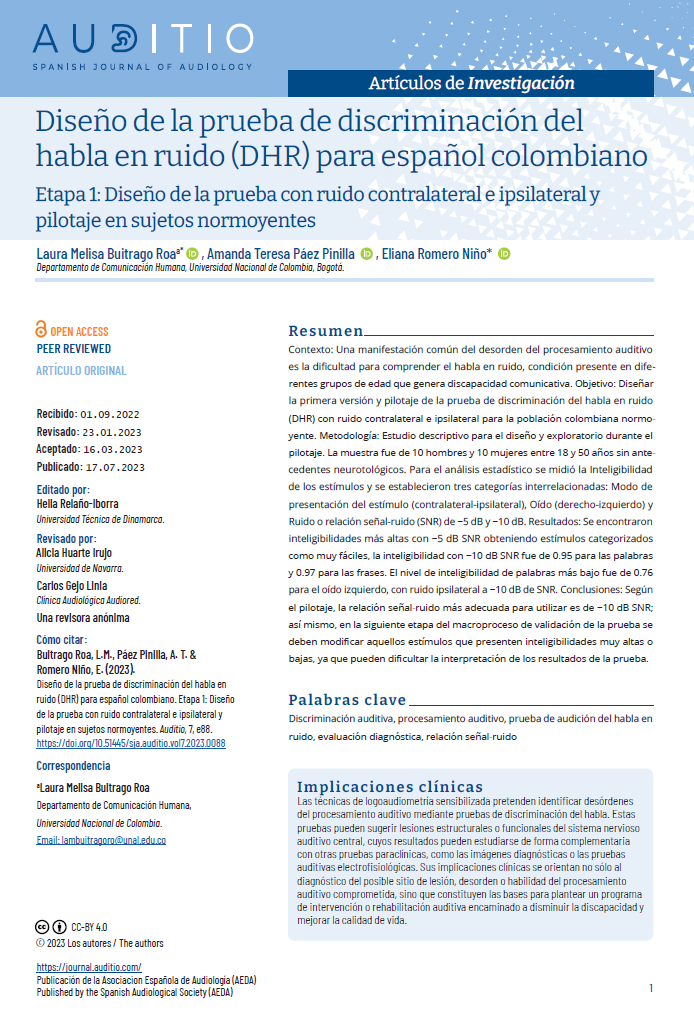Colombian Spanish design of the speech-in-noise discrimination test
Stage 1: Design of a contralateral and ipsilateral noise test and piloting in individuals with normal hearing
DOI:
https://doi.org/10.51445/sja.auditio.vol7.2023.0088Keywords:
auditory discrimination, auditory processing, speech in noise test, clinical evaluation, signal to noise ratioAbstract
Context: Difficulty understanding speech in noise is a common symptom of auditory processing disorders that impairs communication and affects different age groups. Objective: To design a first version of a speech-in-noise (SIN) discrimination test with contralateral and ipsilateral noise and pilot the test in the normal-hearing Colombian population. Method: Descriptive, exploratory study for test design and piloting. The pilot sample consisted of 10 men and 10 women aged 18-50 years without a neurotological history. For the statistical analysis, intelligibility of stimuli was measured and three interrelated categories were defined: Mode (contralateral or ipsilateral presentation of stimulus), Ear (left or right) and Noise (signal-noise ratio [SNR] of −5 dB and −10 dB). Results: The highest intelligibility was observed at −5 dB SNR, and stimuli were categorized as very easy; intelligibility at −10 dB SNR was 0.95 for words and 0.97 for sentences. The lowest intelligibility for words was 0.76 for the left ear, with ipsilateral noise at −10 dB SNR. Conclusions: According to our pilot test, the most suitable SNR is −10 dB. In the next stage of this test validation macroprocess, stimuli that were found to have very high or very low intelligibilities should be modified because they may hinder the interpretation of the test results.
Downloads
Visibility and Altmetrics
Metrics
Global Statistics ℹ️
|
2046
Views
|
3352
Downloads
|
|
5398
Total
|
|
References
Aubanel, V., Garcia Lecumberri, M. L., & Cooke, M. (2014). The Sharvard Corpus: A phonemically-balanced Spanish sentence resource for audiology. International Journal of Audiology, 53(9), 633-638. 10.3109/14992027.2014.907507
Auditory processing disorder (APD). The American Academy of Audiology. (2022, February 9). Retrieved August 16, 2022, from https://www.audiology.org/practice-resources/coding/codingfrequently-asked-questions/auditory-processing-disorder-apd/
Barón de Otero, C., Brik, G., Flores, L., Ortiz, S., & Abdala, C. (2008). The Latin American Spanish Hearing in Noise Test. International Journal of Audiology, 47(6), 362–363. doi:10.1080/14992020802060888
Baytukalov, T. (s/f). Spanish pronunciation tool - IPA phonetic transcription. Easypronunciation.com. Retrieved on November 20, 2021 from: https://easypronunciation.com/en/spanish-phonetic- transcriptionconverter
Cañete S, O. (2006). Desorden del procesamiento auditivo central (DPAC). Revista de otorrinolaringología y cirugía de cabeza y cuello, (66), 263-273.
Etymotic Research INC. (2001). QuickSIN Speech in Noise test. https://manualzz.com/doc/6926774/etymotic-quicksin-speech-in-noisetest-user-manual
Etymotic Research INC. (2005). BKB SIN user Manual. Retrieved in November 2021 from https://manualzz.com/manual/Etymotic/BKB-SIN%20Speech-in-Noise%20Test/
Fuente, A., & McPherson, B. (2006). Auditory processing tests for Spanishspeaking adults: An initial study. International Journal of Audiology, 45(11), 645–659. doi:10.1080/14992020600937238
Geffner, D., & Ross-Swain, D. (2019). Auditory Processing Disorders: Assessment, Management, and Treatment. Plural Publishing Inc.
Hornsby, B. (2004) El índice de inteligibilidad del habla: ¿Qué es y para qué sirve? The Hearing Journal 57(10):p 10-17.
Ibáñez Martínez, M. J., & Muro Jiménez, M. B. (2015, marzo). Estimulación de la vía auditiva: materiales. Revista nacional e internacional de educación inclusiva, 8(1), 134-147.
Institute of Electrical and Electronics Engineers. (1969). IEEE recommended practice for speech quality measurements. IEEE Transactions on Audio and Electroacoustics, 17(3), 225-246.
Katz, J. (1994). Handbook of Clinical Audiology. Williams/Wilkins. Fourth Edition. 14, 197 – 208.
Killion, M. C., Niquette, P. A., Gudmundsen, G. L Revit LJ & Banerjee S. (2004, October). Development of a quick speech-in-noise test for measuring signal-to-noise ratio loss in normal-hearing and hearing-impaired listeners. J. Acoust. Soc. Am., 116(4), 2395-2040.
Killion, M. C., and Villchur, E. (1993). "Kessler Was Right-Partly: But SIN Test Shows Some Aids Improve Hearing in Noise," Hear. J. 46(9), 31-35.
MINSALUD, Organización Panamericana de Salud, & Organización Mundial de la Salud. (2016). ANÁLISIS DE SITUACIÓN DE LA SALUD AUDITIVA Y COMUNICATIVA EN COLOMBIA Convenio 519 de 2015.
Nilsson, M., Soli, S. D., & Sullivan, J. A. (1994). Development of the Hearing In Noise Test for the measurement of speech reception thresholds in quiet and in noise. The Journal of the Acoustical Society of America, 95(2), 1085. 10.1121/1.408469
Páez, A. (2001). Diseño y validación de la batería de evaluación del procesamiento auditivo dicótico (BEPADI) en sujetos sin antecedentes Neurootológicos. AUDIOLOGIA HOY. Asoaudio, ISSN 1657-723X (1), 17-22.
Quirós, J. B., & D'Elia, E. N. (1974). La audiometría del adulto y del niño. Ed. Paidós.
Real Academia española (s/f) Banco de datos (CREA) [ versión 3.0 en línea]. Corpus de referencia del español actual. Retrieved on September 10, 2021 from: <http://www.rae.es>
Seonģ, H. L., Hyun, J. S., Sang, W. Y., & Kyoung, W. L. (2009). Effects of Various Background Noises on Speech Intelligibility of Normal Hearing Subjects. Korean Journal of Otolaryngology-Head and Neck Surgery, 52(4), 307-311. 10.3342/kjorl-hns.2009.52.4.307
Wilson, R. H., McArdle, R. A., & Smith, S. L. (2007). An Evaluation of the BKBSIN, HINT, QuickSIN, and WIN Materials on Listeners With NormalHearing and Listeners With Hearing Loss. Journal of Speech, Language, and Hearing Research, 50(4), 844-856. 10.1044/1092-4388(2007/059).

Downloads
Published
How to Cite
License
Copyright (c) 2023 Laura Melisa Buitrago Roa, Amanda Teresa Paez Pinilla, Eliana Romero Niño

This work is licensed under a Creative Commons Attribution 4.0 International License.
All articles will be published under the open Creative Commons Attribution (CC-BY) license. This license allows others to share and adapt the content, even for commercial purposes, as long as appropriate credit is given to the authors and the journal. By submitting their manuscript, authors retain copyright but grant the journal the right to make the first publication under this license.
More information about this license is available at: https://creativecommons.org/licenses/by/4.0/
Articles published between 2001 and 2020
The texts published in this journal in the section "AUDITIO 2001-2020" are subject - unless otherwise indicated - to a Creative Commons Attribution 3.0 Spain license. You can copy, distribute, communicate them publicly, make derivative works and commercial uses provided that you acknowledge the credits of the works (authorship, name of the journal, publishing institution) in the manner specified by the authors or by the journal. The full license can be consulted at http://creativecommons.org/licenses/by/3.0/es/deed.es.









